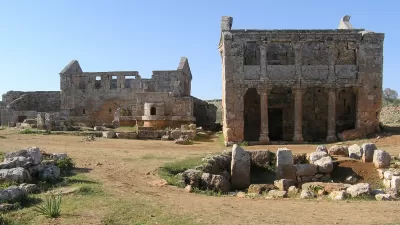It's still far from clear what the political outcome of Syria's civil war will be. But for the country's built environment, the effects are stunningly evident. Millions of buildings have been damaged or destroyed since March 2011.
Compared to the estimated 30,000 killed during the war, the widespread damage and destructuion of Syria's homes, schools, mosques, churches and hospitals is but a footnote. But the truth remains that "[m]uch of Syria has become a disaster zone."
According to Los Angeles Times staff, "[o]n streets once lined with multistory buildings and mosques, ceilings lie pancaked atop smashed and dusty home furnishings and appliances. Electrical wires hang like carelessly strung streamers across concrete columns strewn with antigovernment graffiti. Roads in front of gutted shops have become impassable for the sheer amount of rubble."
As we noted before, some of the world's most treasured historical sites have been damaged in the fighting. With a new law that allows for the demolition of "illegally contructed buildings," the government is opening a new front in the destrcution of the social fabric of the country. "More than half the buildings in Damascus are illegally built, in part because the country's urban planning hasn't been updated in 40 years, said Radwan Ziadeh, director of the Damascus Center for Human Rights and a member of the opposition Syrian National Council."
"The main idea behind [the law] was to punish all these areas where they have a strong presence of the Free Syrian Army," Ziadeh said. "They need to destroy the social support" for the rebels in Damascus and the suburbs.
"The regime is using the excuse of urban planning to demolish entire buildings," said Lena Shami, an activist in Damascus. "But what are the chances that it ignored the issue for all these years and now remembered it? And they haven't given residents any warning or reimbursement."
FULL STORY: Conflict has left Syria a shell of its former self

Manufactured Crisis: Losing the Nation’s Largest Source of Unsubsidized Affordable Housing
Manufactured housing communities have long been an affordable housing option for millions of people living in the U.S., but that affordability is disappearing rapidly. How did we get here?

Americans May Be Stuck — But Why?
Americans are moving a lot less than they once did, and that is a problem. While Yoni Applebaum, in his highly-publicized article Stuck, gets the reasons badly wrong, it's still important to ask: why are we moving so much less than before?

Using Old Oil and Gas Wells for Green Energy Storage
Penn State researchers have found that repurposing abandoned oil and gas wells for geothermal-assisted compressed-air energy storage can boost efficiency, reduce environmental risks, and support clean energy and job transitions.

Colorado Lawmakers Move to Protect BRT Funding
In the face of potential federal funding cuts, CDOT leaders reasserted their commitment to planned bus rapid transit projects.

Safe Streets Funding in Jeopardy
The Trump administration is specifically targeting bike infrastructure and other road safety projects in its funding cuts.

Six Reasons Why Housing Is a Human Right
Is housing a human right? A law professor shares six reasons why it should be, from its role in protecting other rights to global recognition and U.S. legal traditions. As public support grows, could housing be the next right written into law?
Urban Design for Planners 1: Software Tools
This six-course series explores essential urban design concepts using open source software and equips planners with the tools they need to participate fully in the urban design process.
Planning for Universal Design
Learn the tools for implementing Universal Design in planning regulations.
Heyer Gruel & Associates PA
City of Moreno Valley
Institute for Housing and Urban Development Studies (IHS)
City of Grandview
Harvard GSD Executive Education
Salt Lake City
NYU Wagner Graduate School of Public Service
City of Cambridge, Maryland



























